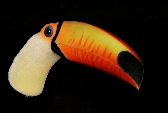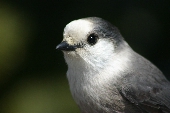|
|
|
The word Nesher, is invariably translated
in the Authorized Version of the Christian Bible as "Eagle". However,
the Nesher which was undoubtedly not actually the Eagle, but a different
kind of bird, and has satisfactorily been identified with the Griffon Vulture
or Great Vulture. The reasons for this conclusion are so inextricably interwoven
with the various passages in which the bird is mentioned.
In the first place,
the name Nesher is derived, according to many Hebraists, from a word which
signifies the power of sight, and is given to the bird in consequence of
its piercing vision. I'he Talmudical writers mention a curious proverb
concerning the sight of the Vulture, namely that a Vulture in Babylon can
see a carcase in Palestine. Other scholars derive it from a word
which signifies its longevity, while others again believe that the true
derivation is to be found in a word which signifies ripping up or tearing
with the beak.
Allusion is made in the Scriptures to the
gregarious habits of the Vultures:
"Wheresoever the carcase is, there will the eagles be gathered
together" (Matt. xxiv; 28). That the Vulture, and not the eagle, is
here signified, is evident from the fact that the eagles do not congregate
like the Vultures, never being seen in greater numbers than two or three
together, while the Vultures assemble in hundreds.
The featherless head
of the Vulture is mentioned in the Book of Micah, chap. i. ver. 16: 'Make
thee bald, and poll thee for thy delicate children; enlarge thy baldness
as the eagle; for they are gone into captivity from thee.' It is evident
that in this passage reference is made, not to the eagle, whose head is
thickly covered with feathers, but to the Vulture, whose head and neck
are but scantily sprinkled with white down. Some commentators, not aware
that the word nesher should have been rendered as 'vulture'
have explained the passage by saying that the prophet referred to
the moulting-time of the eagle. However, such an explanation is at
the best a forced one, whereas the reference to the bald head of the Vulture
is both simple and natural. The voracity of the Vulture,
and its capacity for discovering food, are both mentioned in Job xxxix.
27-30 : ' Doth the eagle (nesher)
mount up at thy command, and
make her nest on high?
'She dwelleth and abideth on the rock,
upon the crag of the rock, and the strong place.
'From thence she seeketh the prey, and
her eyes behold afar off.
'Her young ones also suck-up blood:
and where the slain are, there is she.'
See also Hab. i. 6-8, in which the prophet
speaks of the Chaldeans, 'that bitter and hasty nation, which shall
march through the breadth of the land, to possess the dwelling places that
are not theirs.
'They are terrible and dreadful:. .
.and their horsemen shall spread themselves, and their horsemen shall come
from afar; they shall fly as the eagle that hasteth to eat.'
There is also a curious passage in the
Book of Proverbs, chap. xxx. ver. 17, which alludes to the carnivorous
nature of the bird: 'The eye that mocketh at his father, and despiseth
to obey his mother, the ravems of the valley shall pick it out, and the
young eagles shall eat it'
Allusion is made in several passages to
the swiftness of the Vulture, as well as its voracity. See, for example,
a portion of David's lamentation over the bodies of Saul and Jonathan,
who, according to the poet's metaphor, 'were lovely and pleasant in
their lives, and in their death they were not divided; they were swifter
than eagles, they were stronger than lions.'
'I'he 'bitter' people-namely, the Chaldeans-are
again mentioned in a very similar manner by the prophet Jeremiah : 'Our
persecutors are swifter than the eagles of the heavens ; they pursued us
upon the mountains, they laid wait for us in the wilderness' (Lam.
iv. 19).
The Griffon Vulture's long life is noticed in the well-known Bible passage, "Bless the Lord, O my soul,
and forget not all His benefits:. . .who satisfieth thy mouth with good
things; so that.thy youth is renewed like the eagle's" (Psalms. ciii.
1, 5).
This passage has often been misinterpreted
by commentators who have not appreciated the metaphorical style of all
Oriental poetry. Taking the passage in its exact literal sense, and not
knowing that reference made to the Vulture and not to the eagle, they have
taken for granted that the eagle had some mode of renewing its youth, and,
in fact, after becoming old, went through some process by which it shook
off the decrepitude of old age, and became young again. Others, seeing
that such an interpretation was both strained and far-fetched, have thought
that reference was made to the annual moult of the eagle, which they fancied
to be of a very severe character, the whole of the feathers being shed
at once, so as to have the bird naked and helpless, and then being restored
with added strength and beauty.
It is evident, however, that no such interpretation
is needed, and that the Psalmist, when using the expression, 'renewing
the youth like an eagle's,' only employed a metaphorical expression
significative of longevity.
|
|
|
The fondness of the Vulture for building
its nest in high localities and rocky caves is more than once mentioned
in Holy Writ. One of these passages, which occurs in Job xxxix. 29, has
already been quoted above, and another, and equally forcible one, is to
be found in the Book of the Prophet Jeremiah: 'Thy terribleness hath
deceived thee, and the pride of thine heart, O thou that dwellest in the
clefts of the rock, that holdest the height of the hill: though thou shouldest
make thy nest as high as the eagle (nesher),
I will bring thee down from
thence, saith the LORD' (Jer. xlix. 16).
Even the way that the parent birds encourage
and accompany their young on their first flight has been noted by the Biblical
writers, and has been forcibly employed as an image of divine protection.
See the Song of Moses, in which the aged. leader, whose forty years' work
was at last finished, recapitulates the mercies vouchsafed to the people
of Israel, and exhorts them against the sin of ingratitude: 'For .the
LORD'S portion is his people; Jacob is the lot of His inheritance. He found
him in a desert land, and in the waste bowling wilderness; He led him about,
He instruded hi, He kept him as the apple of His eye.
'As an eagle stirreth up her nest, fluttereth
over her young, spreadeth abroad her wings, taketh them, beareth them on
her wings;
'So the LORD alone did lead him, and
there was no strange god with him' (Deut. xxxii. 9-12).
The strength of flight of the Vulture is
also noticed by the sacred writers. See, for example, Exod. xix. 4: 'Ye
have seen what I did to the Egyptians, and, how I bare you on eagles' (nesherim)
wings, and brought you unto myself.'
This passage had a peculiar force when
addressed to the Hebrews, the Vulture being one of the chief emblems of
Egyptian power, and its outspread wings continually recurring on the grand
monuments and temples with which they must have been so familiar.
|
|
Strangely enough, in their second captivity,
the Jews met with the same emblem among the Assyrians. For example, their
god Nisroch, whom we find mentioned as specially worshipped by Sennacherib,
was a vulture-headed deity, bearing not only. the head of the bird, but
also its wings. The vast wings of the Vulture were by the Assyrians used
as types of Divine power, and were therefore added, not only to human figures,
but to those of beasts. The human-headed and vulture-winged bulls
of Nineveh, with which we are now so familiar, are good examples of this
peculiar imagery.
The name Nisroch, by the way, is
evidently the same word as nesher,
and bears even closer resemblance
to the Arabic niss'r. This bird was also the war standard of Assyria,
just as the eagle is that of France, and the metaphors used by Habbakuk
and Jeremiah had therefore a doubly forcible sense.
We find the same bird employed as a visible
emblem of Divine omnipresence and omniscience in the visions seen by Ezekiel
and St. John: 'And everyone had four faces; the first face was the face
of a cherub, and the second face was the face of a man, and the third the
face of a lion, and the fourth the face of an eagle' (Ezek. x. 14).
Then, in the Revelation, chap. iv. ver. 6, 7, is the account of a vision
of very similar character: 'In the midst of the throne; and round about
the throne, were four beasts full of eyes before and behind.'
'And the first beast was like a lion,
and the second was like a calf, and the third beast had a face as a man,
and the fourth beast was like a flying eagle.'
Viewing these various passages in which
the Nesher is mentioned in the Bible, we shall find that the sacred writers
were thoroughly acquainted with the Griffon Vulture, and that.they wrote
of it with an occasional fulness and an invariable precision which shows
how familiar they were with a bird that was once so plentiful and so conspicuous.
|
|
|





